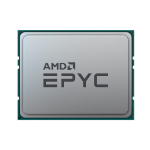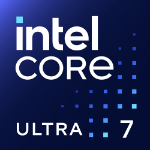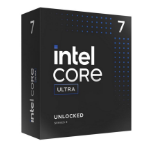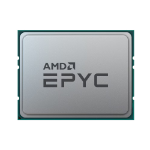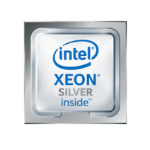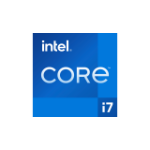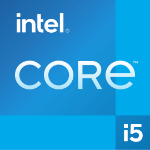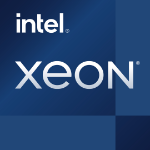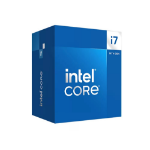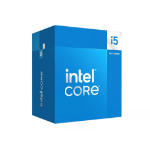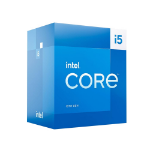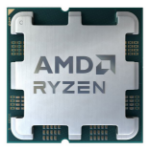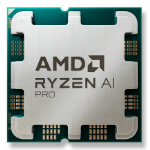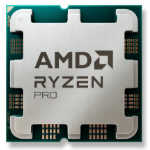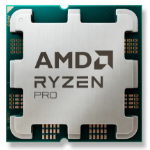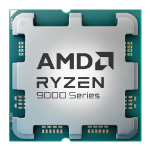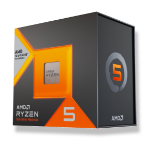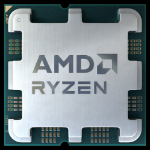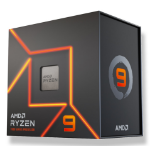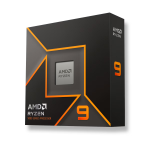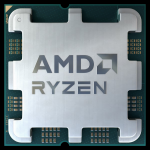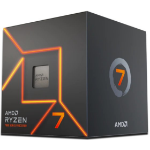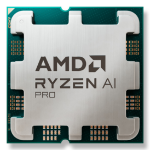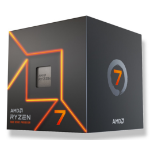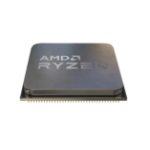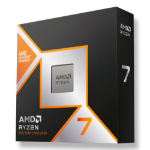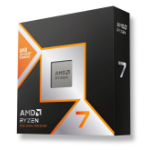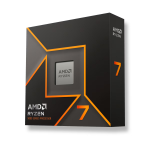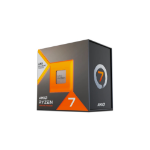AMD Ryzen 7 8700G processor 4.2 GHz 16 MB L3 Box
More Information
| Processor socket | Socket AM5 |
|---|---|
| Box | Yes |
| Processor cores | 8 |
| Processor family | AMD Ryzen 7 |
| SKU | 100-100001236BOX |
| EAN | 0730143316125 |
| Manufacturer | AMD |
| Availability | Y |
| Product Family | Ryzen |
| Product Series | 7 |
Description
The AMD Ryzen 7 8700G is a formidable AM5 processor, boasting an impressive 4.2GHz base clock and featuring 8 cores and 16 threads, making it a powerhouse for multitasking and content creation. With a peak boost clock of 5.1GHz, this processor excels in delivering high-performance computing. Additionally, integrated Radeon Graphics provide smooth visuals, making it an excellent choice for gaming and multimedia tasks. The Ryzen 7 8700G combines robust processing capabilities with advanced graphics, offering a well-rounded solution for users seeking both CPU and GPU performance in a single package.
Greatness Starts Here
Incredible PC gaming is within your reach. Get your hands on an AMD Ryzen™ 8000G Series processor and start playing in high definition out of the box. With the power of Radeon™ 700M graphics built-in, the complete experience your game deserves is finally here.
Play Games Without A Graphics Card
AMD Ryzen 8000G Series processors come with Radeon 700M series graphics built in to get you in the game, no graphics card necessary. And if you want to go beyond, like all AMD Ryzen processors, 8000G Series models are compatible with graphics cards for even more performance.
AMD RYZEN™ AI Technology
The first desktop processor with AI capabilities is here, and you can be the first to have it. AMD Ryzen™ AI includes a dedicated AI engine designed for the ultimate in AI processing efficiency; an AMD Radeon™ graphics engine optimised for AI workloads; and Ryzen™ processor cores that also have powerful AI capabilities.
The Benefits of an AMD Ryzen™ Processor
Get a competitive edge with your AMD Ryzen processor. Overclock at the touch of the button and take charge with total performance mastery through Ryzen Master. The cutting-edge tech of AMD EXPO Memory ensures a smooth, personalised experience. Upgrades and customisations are within your grasp on the AMD Socket AM5 ecosystem.
Specifications
| Processor | |
|---|---|
| Processor generation | AMD Ryzen 8000 Series |
| Processor base frequency | 4.2 GHz |
| Processor manufacturer | AMD |
| Cooler included | Yes |
| Configurable TDP-down | 45 W |
| Thermal Design Power (TDP) | 65 W |
| Processor cache | 16 MB |
| Processor model | 8700G |
| Processor threads | 16 |
| Processor operating modes | 64-bit |
| Processor boost frequency | 5.1 GHz |
| Processor lithography | 4 nm |
| Processor family | AMD Ryzen™ 7 |
| Processor cores | 8 |
| Processor socket | Socket AM5 |
| Configurable TDP-up | 65 W |
| Processor cache type | L3 |
| Package type | Box |
| Memory | |
| Memory types supported by processor | DDR5-SDRAM |
| Memory clock speeds supported by processor | 3600,5200 MHz |
| Memory channels | Dual-channel |
| Graphics | |
| Discrete graphics card | No |
| On-board graphics card model | AMD Radeon 780M |
| On-board graphics card | Yes |
| On-board graphics card base frequency | 2900 MHz |
| Discrete graphics card model | Not available |
| Power | |
| Configurable TDP-down | 45 W |
| Thermal Design Power (TDP) | 65 W |
| Technical details | |
|---|---|
| PCI Express slots version | 4.0 |
| Compatible operating systems | Windows 11/10 x64, RHEL x86 64-bit, Ubuntu x86 64-bit |
| Thermal Design Power (TDP) | 65 W |
| Market segment | Desktop |
| Configurable TDP-up | 65 W |
| Processor cache type | L3 |
| Features | |
| Thermal Design Power (TDP) | 65 W |
| PCI Express slots version | 4.0 |
| Compatible operating systems | Windows 11/10 x64, RHEL x86 64-bit, Ubuntu x86 64-bit |
| Market segment | Desktop |
| Processor special features | |
| Configurable TDP-up | 65 W |
| Packaging data | |
| Package type | Box |
Delivery Details
- UK distributors.
- Order before 4 pm for next-day delivery.
- Standard (2-3 days) £7.50
- Next Day £9.99
- Free standard delivery over £100
There are deivery surcharges to these postcodes:
| Postcode | Charge |
| IV3-40 | £20 |
| IV52-54 | £20 |
| IV63 | £20 |
| KW1-14 | £20 |
| PA10-40 | £20 |
| PH19-40 | £20 |
| PH50 | £20 |
| HS | £50 |
| IV41-51 | £50 |
| IV55-56 | £50 |
| KA27-28 | £50 |
| KW15-17 | £50 |
| PA41-49 | £50 |
| PA60-62 | £50 |
| PA76-78 | £50 |
| PH41-44 | £50 |
| ZE | £50 |
| IM | £50 |
| JE | £50 |
| GY | £50 |
| TR21-25 | £50 |
| BT | £20 |
AMD EPYC 4364P processor 4.5 GHz 32 MB L3
Shop NowIntel Core Ultra 7 265F processor 30 MB Smart Cach...
Shop NowIntel Core Ultra 7 265 processor 30 MB Smart Cache...
Shop NowIntel Core Ultra 7 265F processor 30 MB Smart Cach...
Shop NowAMD EPYC 4345P processor 3.8 GHz 32 MB L3 Tray
Shop NowHPE Intel Xeon-Silver 4210R processor 2.4 GHz 13.7...
Shop NowHPE Intel Xeon-Silver 4210R processor 2.4 GHz 13.7...
Shop NowIntel Core i7-11700T processor 1.4 GHz 16 MB Smart...
Shop NowIntel Core i5-12600 processor 18 MB Smart Cache Bo...
Shop NowIntel Xeon E-2356G processor 3.2 GHz 12 MB Smart C...
Shop NowIntel Xeon E-2374G processor 3.7 GHz 8 MB Smart Ca...
Shop NowIntel Core i9-12900KF processor 30 MB Smart Cache
Shop NowHPE Intel Xeon-Silver 4210R processor 2.4 GHz 13.7...
Shop NowHPE Intel Xeon-Silver 4210R processor 2.4 GHz 13.7...
Shop NowIntel Xeon E-2324G processor 3.1 GHz 8 MB Smart Ca...
Shop NowIntel Core i7-13700F processor 30 MB Smart Cache B...
Shop NowIntel Core i9-14900KF processor 36 MB Smart Cache ...
Shop NowIntel Core i9-14900K processor 36 MB Smart Cache B...
Shop NowIntel Core i7-14700KF processor 33 MB Smart Cache ...
Shop NowIntel Core i7-14700F processor 33 MB Smart Cache B...
Shop NowIntel Core Ultra 7 265K processor 30 MB Smart Cach...
Shop NowIntel Core i5-14400 processor 20 MB Smart Cache Bo...
Shop NowIntel Core Ultra 7 265KF processor 30 MB Smart Cac...
Shop NowIntel Core Ultra 7 265KF processor 30 MB Smart Cac...
Shop NowIntel Core i5-13500 processor 24 MB Smart Cache Bo...
Shop NowIntel Core i7-13700F processor 30 MB Smart Cache T...
Shop NowIntel Core i7-13700K processor 30 MB Smart Cache
Shop NowIntel Core i7-12700 processor 25 MB Smart Cache
Shop NowIntel Core i9-12900K processor 30 MB Smart Cache T...
Shop NowIntel Xeon W-2225 processor 4.1 GHz 8.25 MB Tray
Shop NowIntel Core i9-12900K processor 30 MB Smart Cache B...
Shop NowIntel Core i9-12900KF processor 30 MB Smart Cache ...
Shop NowIntel Core i7-14700F processor 33 MB Smart Cache T...
Shop NowIntel Core i7-12700 processor 25 MB Smart Cache Bo...
Shop NowIntel Core i9-14900K processor 36 MB Smart Cache T...
Shop NowIntel Core i7-14700K processor 33 MB Smart Cache B...
Shop NowIntel Core i7-12700K processor 25 MB Smart Cache B...
Shop NowIntel Core i5-13400 processor 20 MB Smart Cache Bo...
Shop NowAMD Ryzen 9 7900X processor 4.7 GHz 64 MB L3 Box
Shop NowAMD Ryzen 5 7600X3D processor 4.1 GHz 96 MB L3
Shop NowAMD Ryzen 5 PRO 8600G processor 4.3 GHz 16 MB L3
Shop NowAMD Ryzen 5 PRO 8600G processor 4.3 GHz 16 MB L3
Shop NowAMD Ryzen 5 PRO 8500G processor 3.5 GHz 16 MB L3
Shop NowAMD Ryzen 9 9900X processor 4.4 GHz 76 MB L2 & L3 ...
Shop NowAMD Ryzen 5 7500X3D processor 4 GHz 96 MB L3 Box
Shop NowAMD Ryzen 5 PRO 8500G processor 3.5 GHz 16 MB L3
Shop NowAMD Ryzen 9 5900XT processor 3.3 GHz 72 MB L2 & L3...
Shop NowAMD Ryzen 5 5600G processor 3.9 GHz 16 MB L3 Box
Shop NowAMD Ryzen 9 5950X processor 3.4 GHz 64 MB L3 Box
Shop NowAMD Ryzen 5 7600X processor 4.7 GHz 32 MB L3 Tray
Shop NowAMD Ryzen 9 7900X processor 4.7 GHz 64 MB L3 Tray
Shop NowAMD Ryzen 9 7900 processor 3.7 GHz 64 MB L3 Box
Shop NowAMD Ryzen 9 7900 processor 3.7 GHz 64 MB L3 Box
Shop NowAMD Ryzen 9 9900X processor 4.4 GHz 76 MB L2 & L3 ...
Shop NowAMD Ryzen 7 7700 processor 3.8 GHz 32 MB L3 Tray
Shop NowAMD Ryzen 7 7700 processor 3.8 GHz 32 MB L2 & L3 B...
Shop NowAMD Ryzen 7 8700G processor 4.2 GHz 16 MB L3 Tray
Shop NowAMD Ryzen 7 7700 processor 3.8 GHz 32 MB L3 Box
Shop NowAMD Ryzen 7 5700X processor 3.4 GHz 32 MB L3 Tray
Shop NowAMD Ryzen 7 7700X processor 4.5 GHz 32 MB L3 Tray
Shop NowAMD Ryzen 7 9700X processor 3.8 GHz 40 MB L2 & L3 ...
Shop NowAMD Ryzen 7 7800X3D processor 4.2 GHz 96 MB L3 Tra...
Shop NowAMD Ryzen 7 9800X3D processor 4.7 GHz 104 MB L2 & ...
Shop NowAMD Ryzen 7 9800X3D processor 4.7 GHz 96 MB L3 Tra...
Shop NowAMD Ryzen 7 9700X processor 3.8 GHz 40 MB L2 & L3 ...
Shop NowAMD Ryzen 7 7800X3D processor 4.2 GHz 96 MB L3 Box
Shop NowYou may also be interested in
| Product |
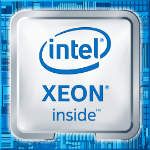 Intel Xeon W-2225 processor 4.1 GHz 8....
Intel Xeon W-2225 processor 4.1 GHz 8....
£379.60
£316.33
|
 AMD Ryzen 9 5950X processor 3.4 GHz 64...
AMD Ryzen 9 5950X processor 3.4 GHz 64...
£314.60
£262.17
|
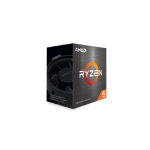 AMD Ryzen 5 5600G processor 3.9 GHz 16...
AMD Ryzen 5 5600G processor 3.9 GHz 16...
£259.10
£215.92
|
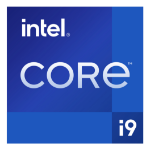 Intel Core i9-12900K processor 30 MB S...
Intel Core i9-12900K processor 30 MB S...
£338.62
£282.18
|
 Intel Core i9-12900KF processor 30 MB...
Intel Core i9-12900KF processor 30 MB...
£307.90
£256.58
|
|---|---|---|---|---|---|
| SKU |
CD8069504394102
|
100-100000059WOF
|
100-100000252BOX
|
BX8071512900K
|
BX8071512900KF
|
| Manufacturer |
Intel
|
AMD
|
AMD
|
Intel
|
Intel
|
| Processor lithography |
up to 22nm
|
up to 22nm
|
up to 22nm
|
N/A
|
N/A
|
| Processor family |
Intel Xeon W
|
AMD Ryzen 9
|
AMD Ryzen 5
|
Intel Core i9
|
Intel Core i9
|
| Processor socket |
LGA 2066 (Socket R4)
|
Socket AM4
|
Socket AM4
|
LGA 1700
|
LGA 1700
|
| Processor cores |
4
|
16
|
6
|
16
|
16
|
| On-board graphics adapter |
N
|
N
|
Y
|
Y
|
N
|
| Discrete graphics adapter |
N
|
N
|
N
|
N
|
N
|
| Cooler included |
N
|
N
|
Y
|
N
|
N/A
|
| Package type |
Tray
|
Box
|
Box
|
Box
|
Box
|




